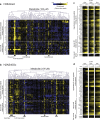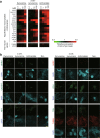Kynurenine, 3-OH-kynurenine, and anthranilate are nutrient metabolites that alter H3K4 trimethylation and H2AS40 O-GlcNAcylation at hypothalamus-related loci
- PMID: 31875008
- PMCID: PMC6930210
- DOI: 10.1038/s41598-019-56341-x
Kynurenine, 3-OH-kynurenine, and anthranilate are nutrient metabolites that alter H3K4 trimethylation and H2AS40 O-GlcNAcylation at hypothalamus-related loci
Abstract
Epigenetic mechanisms can establish and maintain mitotically stable patterns of gene expression while retaining the DNA sequence. These mechanisms can be affected by environmental factors such as nutrients. The importance of intracellular dosages of nutrient metabolites such as acetyl coenzyme A and S-adenosylmethionine, which are utilized as donors for post-translational modifications, is well-known in epigenetic regulation; however, the significance of indirect metabolites in epigenetic regulation is not clear. In this study, we screened for metabolites that function as epigenetic modulators. Because the expression of genes related to hypothalamic function is reportedly affected by nutritional conditions, we used a neural cell culture system and evaluated hypothalamic-linked loci. We supplemented the culture medium with 129 metabolites separately during induction of human-iPS-derived neural cells and used high-throughput ChIP-qPCR to determine the epigenetic status at 37 hypothalamus-linked loci. We found three metabolites (kynurenine, 3-OH-kynurenine, and anthranilate) from tryptophan pathways that increased H3K4 trimethylation and H2AS40 O-GlcNAcylation, resulting in upregulated gene expression at most loci, except those encoding pan-neural markers. Dietary supplementation of these three metabolites and the resulting epigenetic modification were important for stability in gene expression. In conclusion, our findings provide a better understanding of how nutrients play a role in epigenetic mechanisms.
Conflict of interest statement
The authors declare no competing interests.
Figures







Similar articles
-
Tryptophan catabolism in Pseudomonas aeruginosa and potential for inter-kingdom relationship.BMC Microbiol. 2016 Jul 8;16(1):137. doi: 10.1186/s12866-016-0756-x. BMC Microbiol. 2016. PMID: 27392067 Free PMC article.
-
Evaluation of the antioxidant properties of tryptophan and its metabolites in in vitro assay.J Complement Integr Med. 2016 Jun 1;13(2):129-36. doi: 10.1515/jcim-2015-0051. J Complement Integr Med. 2016. PMID: 26641976
-
Catabolism of tryptophan, anthranilate, and 2,3-dihydroxybenzoate in Trichosporon cutaneum.J Bacteriol. 1981 Apr;146(1):291-7. doi: 10.1128/jb.146.1.291-297.1981. J Bacteriol. 1981. PMID: 7194334 Free PMC article.
-
Nutrient regulation of gene expression by O-GlcNAcylation of chromatin.Curr Opin Chem Biol. 2016 Aug;33:88-94. doi: 10.1016/j.cbpa.2016.06.005. Epub 2016 Jun 17. Curr Opin Chem Biol. 2016. PMID: 27322399 Free PMC article. Review.
-
The involvement of DNA methylation and histone modification on the epigenetic regulation of embryonic stem cells and induced pluripotent stem cells.Curr Stem Cell Res Ther. 2014;9(5):388-95. doi: 10.2174/1574888x09666140507154005. Curr Stem Cell Res Ther. 2014. PMID: 24804888 Review.
Cited by
-
A Review of the Evidence for Tryptophan and the Kynurenine Pathway as a Regulator of Stem Cell Niches in Health and Disease.Int J Tryptophan Res. 2024 May 15;17:11786469241248287. doi: 10.1177/11786469241248287. eCollection 2024. Int J Tryptophan Res. 2024. PMID: 38757094 Free PMC article. Review.
-
Effect of diet and intestinal AhR expression on fecal microbiome and metabolomic profiles.Microb Cell Fact. 2020 Nov 30;19(1):219. doi: 10.1186/s12934-020-01463-5. Microb Cell Fact. 2020. PMID: 33256731 Free PMC article.
-
O-GlcNAcylation on serine 40 of histone H2A promotes proliferation and invasion in triple-negative breast cancer.Sci Rep. 2025 Mar 24;15(1):10170. doi: 10.1038/s41598-025-95394-z. Sci Rep. 2025. PMID: 40128346 Free PMC article.
-
Profiling Tryptophan Catabolites of Human Gut Microbiota and Acute-Phase Protein Levels in Neonatal Dried Blood Specimens.Front Microbiol. 2021 Oct 27;12:665743. doi: 10.3389/fmicb.2021.665743. eCollection 2021. Front Microbiol. 2021. PMID: 34777268 Free PMC article.
-
Impact of IDO activation and alterations in the kynurenine pathway on hyperserotonemia, NAD+ production, and AhR activation in autism spectrum disorder.Transl Psychiatry. 2023 Dec 9;13(1):380. doi: 10.1038/s41398-023-02687-w. Transl Psychiatry. 2023. PMID: 38071324 Free PMC article.
References
Publication types
MeSH terms
Substances
LinkOut - more resources
Full Text Sources
Research Materials

